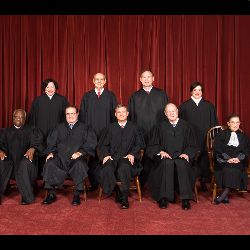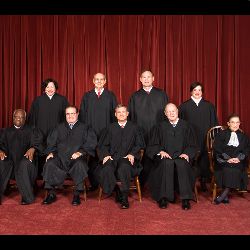
An elite group of Americans have come under fire for being averse to and unknowledgeable about the basic workings and culture surrounding new technology. Despite being viewed as some of the brightest and most accomplished people in their respective field of employ, they have publicly admitted to being resistant to using technology in their own professional and personal lives, and have been ridiculed as woefully out of touch with the basic workings of technology that has been in common use for a decade or more.
This group of individuals is none other than the nine members of the U.S. Supreme Court, who are often asked to rule on cases that are extremely technical in nature.
With an average age of nearly 70 years, no one expects the justices to be regular users of technology developed largely for the young, such as Vine or Instagram. However, the perception that the members of the Court simply do not understand the basic workings or culture surrounding the use of technology has many observers worried about whether the highest court in the land is unprepared or unwilling to make truly informed rulings on today’s pressing Constitutional issues that are impacted by technology.
One of the highest-profile issues the Court is expected to weigh in on focuses on the warrantless search of cellphones, and whether such a search is a violation of the Fourth Amendment’s guarantee of protection against unreasonable search and seizure. This spring, the Supreme Court was scheduled to address cases from California and Massachusetts, respectively, both arising from prosecutions that question the admissibility of evidence obtained through a search of the suspect’s cellphone after arrest.
One of the highest-profile issues the Court is expected to weigh in on focuses on the warrantless search of cellphone content.
Earlier court precedent allows police officers to search all items a person has on them at the time of arrest without requiring a warrant. However, as cellphones have grown to include email, bank history, and location data, the potential problems with the existing standards have become apparent. Furthermore, the ability for people to "wipe" or erase the contents of a device remotely (such as when a phone is lost or stolen) can make the issue more complicated, in terms of balancing personal liberty against the needs of law enforcement.
Such a scenario explicitly highlights the concerns of court watchers such as Mark Grabowski, an attorney and assistant professor of communications who teaches an Internet law course at Adelphi University, regarding the technological knowledge of the judges.
During the oral argument phase of a Supreme Court case several years ago, Chief Justice John Roberts made comments that seemed to indicate he was unaware of how personal pagers functioned, apparently believing messages were transmitted directly between the devices without utilizing a cellular network. While the exchange was played for laughs, Grabowski believes exchanges in oral arguments are often misinterpreted, as court proceedings are not recorded, but simply transcribed. Judges often ask questions that, in transcripts, may look foolish, but serve a purpose in trying to clarify the legal distinctions between certain types of technology.
Grabowksi notes that Chief Justice Roberts, while likely not a technologist per se, probably has a basic understanding of technology, since he said he probably "slept with his BlackBerry" when he was a partner with a major law firm. "On the other hand, if you look at the transcripts of the oral arguments for the past few years, they do seem to reveal some misunderstandings of basic technologies, such as text messaging, online searching, V-chips, voicemail, and even the Kindle reader."
Grabowski is troubled that many justices appear to be not only unfamiliar with technology’s inner workings but, more problematically, also with the ways people can use the technology, both in regular use and how the technology can be exploited in more nefarious ways.
"The implications are profound," Grabowski says. "Speech, expression, and living have become intertwined in technology. If we’re ever to have a case involving Snapchat selfies and eDiscovery, we could be in trouble."
One of the primary reasons for a lack of familiarity or comfort with technology is the average age (currently 67.5) of the Supreme Court Justices, according to the Hon. Richard Posner, a judge of the U.S. Court of Appeals for the Seventh Circuit who, at 75, is actually older than many of the Justices.
"To the extent that judges, including Supreme Court Justices, have had any scientific education, it was many years ago, and how many of us have kept up?" Posner asks. "When I went to law school, there was no instruction in technical matters."
The question remains: Will the Court feel comfortable making broad rulings on high-profile technology-related cases that have significant implications for the lives of everyday Americans? While the NSA surveillance case likely will require additional scrutiny by lower courts before it makes its way to the Supreme Court, technology-based cases expected to come before the court in 2014 include Aereo vs. American Broadcasting Companies, Alice Corporation Pty. Ltd. vs. CLS Bank International, and Limelight Networks vs. Akamai Technologies.
The Aereo case is focused on the applicability of copyright licensing fees paid when a program is streamed to paid users over the Internet. Aereo, a streaming-media company, claims paying retransmission fees is not necessary since the company installs an antenna that receives free high-definition over-the-air broadcast signals for every single customer that signs up for its monthly subscription service. Broadcasters claim the retransmission of network signals without paying retransmission fees is a violation of copyright law.
Will the Court feel comfortable making broad rulings on high-profile technology-related cases that have significant implications for the lives of everyday Americans?
Meanwhile, Alice Corporation Pty. Ltd. vs. CLS Bank International and Limelight Networks vs. Akamai Technologies each focus on patent law. In the first case, the Court must decide whether claims to computer-implemented inventions are able to be patented under current patent law. The second case covers the applicability of patent infringement restitution in cases where no one has committed direct infringement.
Mary-Rose Papandrea, author of "Moving Beyond Cameras in the Courtroom: Technology, the Media, and the Supreme Court," a 2012 paper published by Brigham Young University Law School, explains that based on previous rulings on technology-based cases, the Supreme Court is unlikely to issue broad new rulings. "These opinions reveal that the Court is often cautious in the face of technological developments, not because the Justices do not understand those developments, but rather because they are not confident that they can predict the future of technology and the development of social norms that will surround its use," according to Papandrea. "Furthermore, the Court is generally hesitant to revisit its prior decisions and preexisting doctrinal framework and often chooses to issue more narrow decisions to avoid the difficult jurisprudential questions new technology can present."
Meanwhile, technology cases are being addressed in the high courts around the world. The European Union’s highest court, the European Court of Justice, has issued rulings that barred embryonic stem cell patents, struck down a requirement of social networks to install an anti-piracy filtering system, and is currently addressing a case involving the legal sale of products that can modify Nintendo consoles, which could allow users to bypass certain copyright protections.
The EU’s Court of Justice has not been subject to as much scrutiny as the U.S. Supreme Court, perhaps due to how the court is structured, with one judge per EU country, assisted by nine ‘advocates-general’ whose job is to present opinions on the cases brought before the Court. Each judge and advocate-general is appointed for a term of six years, which can be renewed, and the governments of EU countries must agree on whom they want to appoint. Judges are not appointed for life terms, as U.S. Supreme Court Justices are, and given the more complex selection and appointment process involving a disparate group of EU members, it would stand to reason that these judges and advocates generals are more likely to be current on a greater variety of technologies.
Meanwhile, Japan took the novel step of establishing an Intellectual Property High Court in April 2005 to deal with patent and intellectual property cases. The interesting aspect of this court is its use of judicial research officials and technical advisors, full-time court officials who assist judges by conducting research on technical matters necessary for hearing and resolving IP cases.
Judge Posner has suggested a similar approach to handle highly technical cases at the Supreme Court, which would involve hiring an ad hoc impartial expert agreed upon by both parties in a case to advise the justices about the technology in the case. However, Posner says the likelihood of this occurring is slim, given that the Supreme Court justices are unlikely to agree to any system which puts a focus on the technology, and likely will seek the safe harbor of focusing their decisions based on prior legal rulings and principles.
"As Supreme Court justices, I’m sure they’re very conscious of the importance of their being respected," Posner says. "How does the Court maintain its prestige? It makes them risk-averse. They don’t want to grapple with some technical case and make some terrible mistake; they want, consciously or unconsciously, to operate on a level at which their decisions will be seen as applications of legal principles and legal reasoning, rather than as solutions to technological issues."
Further Reading
Mary-Rose Papandrea
"Moving Beyond Cameras in the Courtroom: Technology, the Media, and the Supreme Court," 2012 BYU L. Rev. 1901 (2012), at http://digitalcommons.law.byu.edu/lawreview/vol2012/iss6/7
Mark Grabowski
"Are Technical Difficulties at the Supreme Court Causing a ‘Disregard of Duty’?" Journal of Law, Technology, and The Internet, 2011, at http://law.case.edu/journals/JOLTI/Documents/Grabowski%20-%20new.pdf
Technology, the Supreme Court, and the Fourth Amendment: Balancing Government Power and Individual Privacy, http://www.soc.umn.edu/~samaha/bill_of_rights/
Supreme Court of the United States Blog: http://www.scotusblog.com/




Join the Discussion (0)
Become a Member or Sign In to Post a Comment